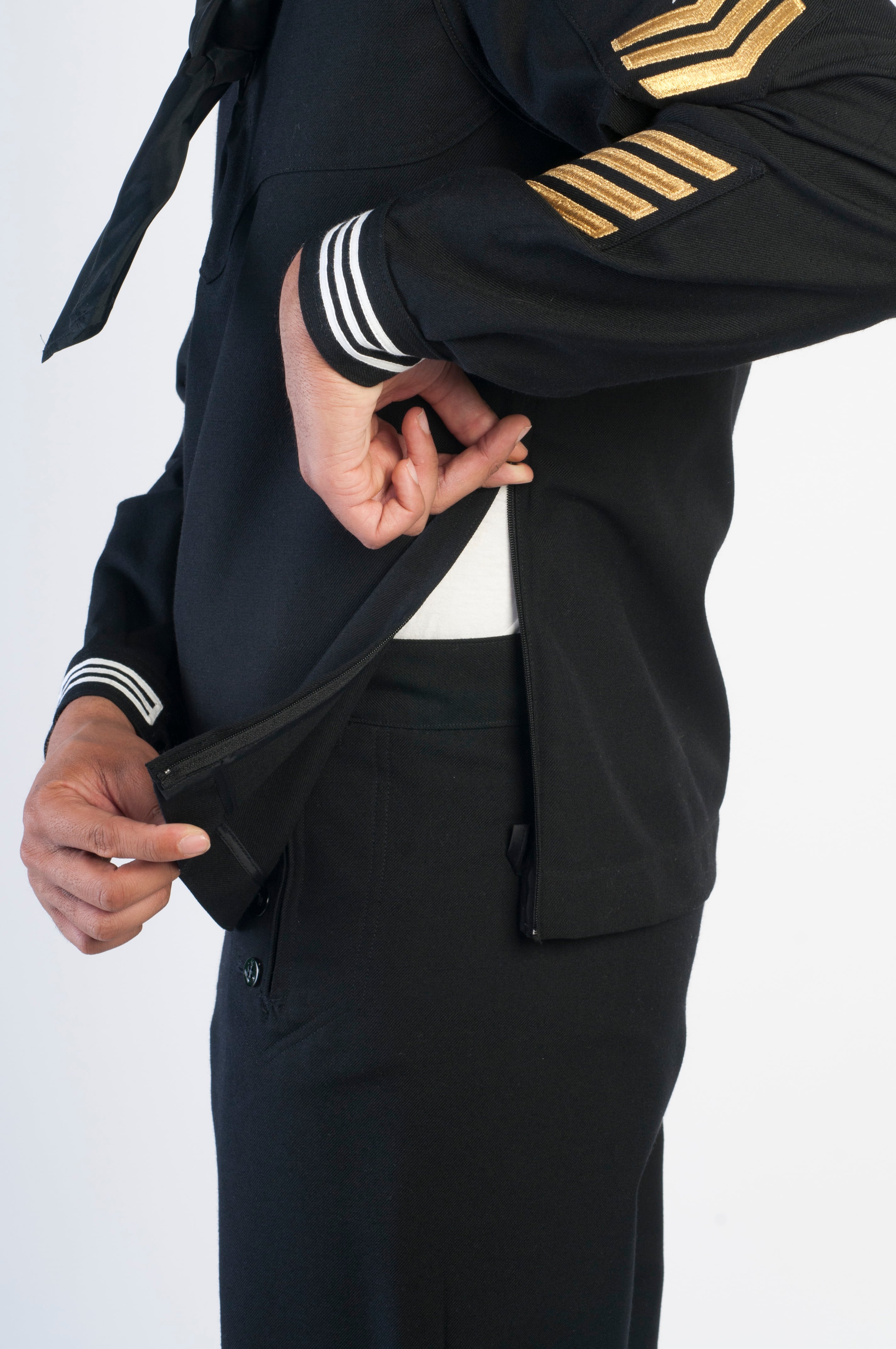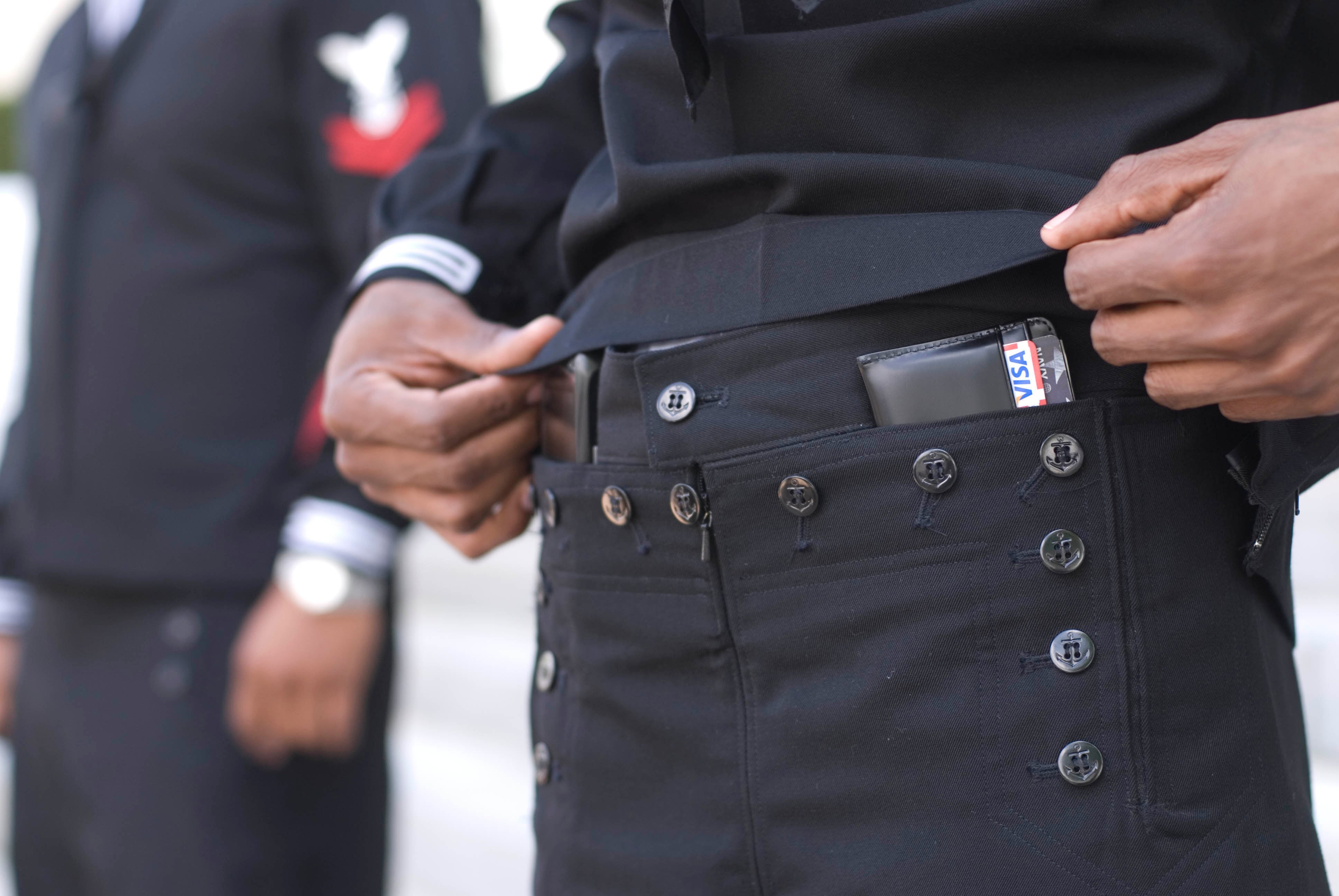The good news: Officials have the money for the long-awaited reboot of dress whites and dress blues.
The bad news: The money isn't available until 2016.
Money problems and a decision to roll-out new women's jumper-style dress blues in tandem with the men's have delayed the roll-out by a year for service dress blues; service dress whites will be delayed for two years.
Men and women, E-6 and below, will be able to buy the service dress blues at the Navy Exchange in early 2016, said Capt. Janet Bristol, head of the Uniform Matters Office. The uniforms are likely to be issued to recruits beginning Oct. 1, 2016, the start of fiscal year 2017. Funding for the crackerjack whites is earmarked for later in?fiscal 2017.
-out of is that the Navy finally has the money to move forward with updated dress blues and the return of dress whites. The bad news is that the money is not available until 2016.
And if initial feedback proves true, adding the Dixie cup for women may be dead in the water.
"We are definitely going forward with it," she said in a recent interview. "We are still formalizing some of our final decisions on the timing and rollout schedule, but the funding is in place, the uniforms will be coming and I think the sailors will enjoy the new features."
The dress blues sport sure-to-be popular updates like a front zipper on the trousers that renders the 13 buttons purely decorative, and a side zipper on the blouse. The dress whites are set for the largest redesign in decades and will have tailored cuffs and piping that matches the blues. But not all changes are being well-received: Many female sailors complain that the "Dixie cup" is easily stained by makeup and doesn't fit hair buns.

The SDB jumper features a side zipper to make the blouse easier to get on and off.
Photo Credit: Alan Lessig/Staff
Many male sailors said they are eager to check out out some of the new features, but not eager to cough up the money to buy a new uniform; a current set costs $87.54.
The cost of the updated threads has not been determined, though Bristol said the new blues "will be a little bit more expensive than the current uniform because of the piping and zippers." The new crackerjacks will start as an optional uniform for sailors and then at some as yet undetermined date become required. That introductory phase can stretch as long as three years, and a longer transition would place less burden on the production schedule, Bristol said.
On the other hand, leadership can expedite the requirement, which is a real possibility. The push for women to adopt the crackerjack style-jumper and the "Dixie cup" have been driven by Navy Secretary Ray Mabus, who wants more uniformity in the ranks.
The male uniform designs were approved in May 2012 after eight years of tests and trials, but the cash-strapped serviceNavy didn't have the funds for full implementation. Officials kept the effort alive by launching a redesign of the female dress blues. About 30 women donned "Dixie cups" and crackerjacks for an initial three-week wear test in May 2014. Slight Modifications were made based on their feedback, and about 275 women in Norfolk-area bases conducted a three-month wear test from November to January.
The plan is to roll out the male and female SDBs together in 2016in tandem. Offering them first at the Navy Exchange allows the Defense Logistics Agency to enter production at a slow and steady pace, and then ramp up for the start of recruit issue later in the year, Bristol said.

Female sailors wear test "Dixie cup" covers and the service dress blue-style jumpers worn by their male peers.
Photo Credit: Lance Bacon/Staff
'Worth the wait'
The new side zippers that will slightly drive up the cost of the blouse but have been a huge hit in wear tests. Taking off the blouse — an effort reminiscent of Houdini wrestling his way out of a straightjacket — is now done with ease thanks to the side zipper that runs down one side of the blouse. The trousers also have a front zipper flanked by two pockets. The 13 buttons remain as a decorative element.
Women are testing a front and side trouser zipper. Bristol said most women have preferred the side zipper. Navy Times has spoken with more than a dozen women whgo took part in the two wear tests, and their preferences have been split down the middle.
Not all the changes are getting rave reviews. Many women dislike the "Dixie cup" as compared with the bucket-style cover they currently wear. The majority of wearers give it a thumbs-down, and for a variety of reasons. Operations Specialist Third3rd Class (SW/AW) Jasmica Harvey said she respects the women who fought long for equality in military service, but that recognition should not come at the expense of their contribution as females.
"I look too much like one of the guys," the seven-year sailor said. "I understand the desire for uniformity, but something should make [us] stand out as females. The combination cover would be much better for this uniform."
Air Traffic Controller Airman Maria Rios-Castaneda also said the combination cover iswould be better because it's dark brim hides the makeup stains that can be seen on the white sailor hat after only one wear. While it is washable, wearers wonder if the stains will fully come out of the white cloth. Other sailors said the "Dixie cup" does not fit right with hair buns.
The uniform is another story. Air Traffic Controller 2ndSecond Class (AW) Cheryl Ehrenfeld has a unique perspective on the fit of the service dress blues. As a member of the honor guard for seven months, she and other women wore the male uniform in the winter.
"It wasn't near as comfortable as this," she said. In addition to the "vast improvement" provided by the zippers (she prefers the zipper in the front of the trousers), the female version is form-fitting. That is an marked improvement over initial tests, in which women found the uniform a bit uncomfortable. Designers made "minor pattern adjustments" from those initial surveys, Bristol said.
Those changes made a difference, sailors observed.
"This uniform is very comfortable. More comfortable than the blazer that we had," Harvey said. "I don't like looking like a stewardess in the current uniform, but I definitely like this," she said, referring to the jumper-style top.
Women sailors currently wear a white shirt and black tie underneath a suit-style coat, instead of a jumper. The current female service dress blues has a white shirt and black tie underneath a black coat, in lieu of a jumper.
The new whites will now mirror the blues in appearance: They feature a yoke around the chest and black piping on the back bib and along the tailored cuffs at the end of the sleeves. Two stars rest in the back bib's corners.
Female wear testers said the they've gotten mostly positive feedback while wearing their prototype uniforms, response to the iconic uniform has been very positive, especially among women. The wear testers have had to endure the occasional joke, and even a harsh look or two. More than one tester has been asked why she was wearing the male uniform.
"There are some design features the fleet is going to enjoy," Bristol said. In addition to the side zipper, she continued, "The piping looks very sharp and will add an additional layer of pride. It's going to be worth the wait."

The redesigned dress blues sport new front pockets that allow sailors to carry items like a wallet and cell phone.
Photo Credit: Mark D. Faram/Staff




